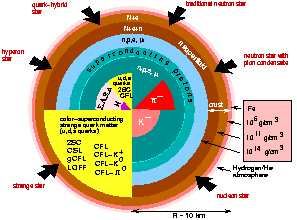Dr. Mark Alford, Washington University St. Louis

Schematic of a compact star; F. Weber,
Strange quark matter and compact stars.
|
High density quark matter and color superconductivity Dr. Mark Alford, Washington University St. Louis |
 Schematic of a compact star; F. Weber, Strange quark matter and compact stars. |
How does matter behave at ultra-high densities? So dense that the atoms themselves collapse, and nuclei are squeezed together. So dense that a supertanker full of oil would be 1 mm3 in size. Amazingly enough, there are places in the universe where this actually happens: neutron stars. Neutron stars are the remnants of ordinary stars that have exploded spectacularly as supernovae. After the explosion, gravity crushes the remaining matter into a super-dense lump called a neutron star or compact star.
Below the surface of the neutron star, the pressure due to gravity is so extreme that there are no longer any atoms: everything is compressed down to a liquid of neutrons, with a few protons and electrons as well. But for my research I am interested in even higher densities. As you burrow down into the core of the neutron star, the pressure rises relentlessly. We don't know what happens at the center, but if the density there is high enough then the neutrons themselves will be crushed out of existence, liberating the quarks inside. If that happens, the core will consist of a liquid of quarks: quark matter. My research is about the properties of quark matter, which turns out to have remarkable similarities to the state of electrons in a metal, including a type of superconductivity called color superconductivity.
For a short popular article on quark matter, see Frontiers 21. A more in-depth review, written for Reviews of Modern Physics is available from the web archive. Wikipedia also contains articles on color superconductivity and quark matter.
Physicists often summarize the properties of matter over a range of
densities and temperatures by drawing a
phase diagram.
Even for a commonplace substance like water, the phase diagram is
surprisingly complicated
when you take into account all the different types of ice.
But I am interested in the phases of matter under far more extreme conditions:
trillions of times denser than ice, and trillions of times hotter than
room temperature.
In this realm we don't have much experimental information to guide us.
In principle we should be able to calculate the behavior of
matter under such conditions, using the the theory that
describes the strong nuclear
force, which is the dominant interaction at ultra-high density.
Unfortunately, this theory,
Quantum ChromoDynamics (QCD)
is difficult to work with, and becomes intractable
when we introduce the chemical potential µ that is needed to
get a finite density of quarks. So we don't really know what the
phase diagram looks like, but we can make a reasonable guess:
Conjectured phase diagram of matter at extreme temperature and density:
![[phase diagram of QCD]](qcd_phasediagram.png)
For a very readable review of the QCD phase diagram, see Simon Hands, "The phase diagram of QCD" (published in Contemp. Phys. 42, 209 (2001)). |
Along the horizontal axis the temperature is zero, and
the density rises from the onset of nuclear matter through the transition to
quark matter. Compact stars are in this region of the phase diagram,
although it is not known whether their cores are dense enough
to reach the quark matter phase. |
The yellow-shaded region of the figure is where quark matter,
which we expect to be color superconducting, will occur.
What do we mean by "color superconducting"?
Think of it by analogy with electrons in a metal. At very low
temperatures (a few Kelvin), most metals suddenly become
superconducting: their resistance drops to zero. This happens
because when it is cold enough the electrons can pair up
forming Cooper pairs
.
We expect that
quarks in quark matter will do something similar.
Topics of ongoing research include:
r-mode spin-down)